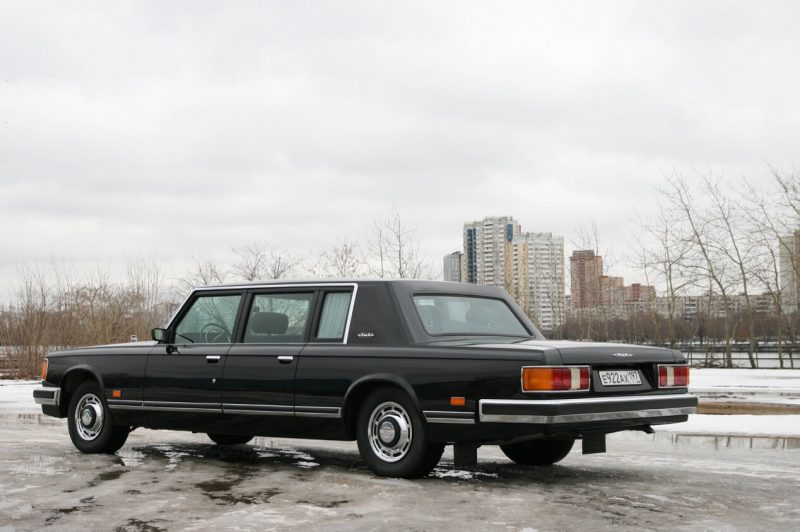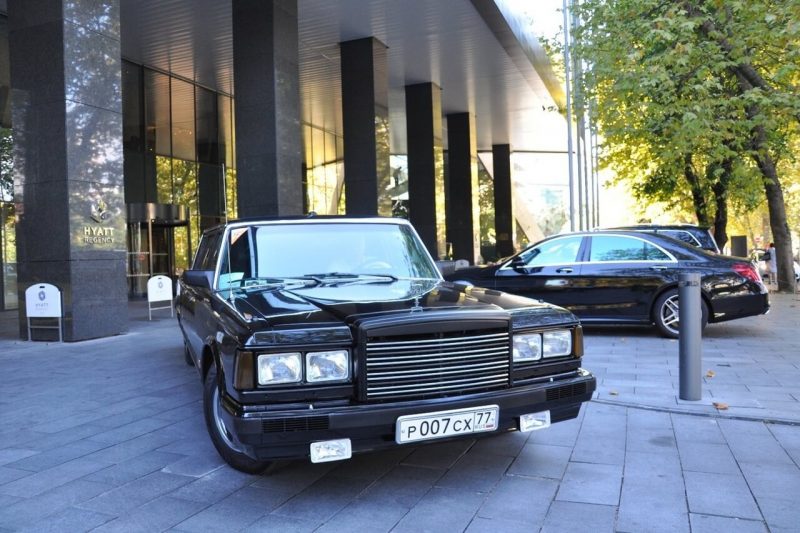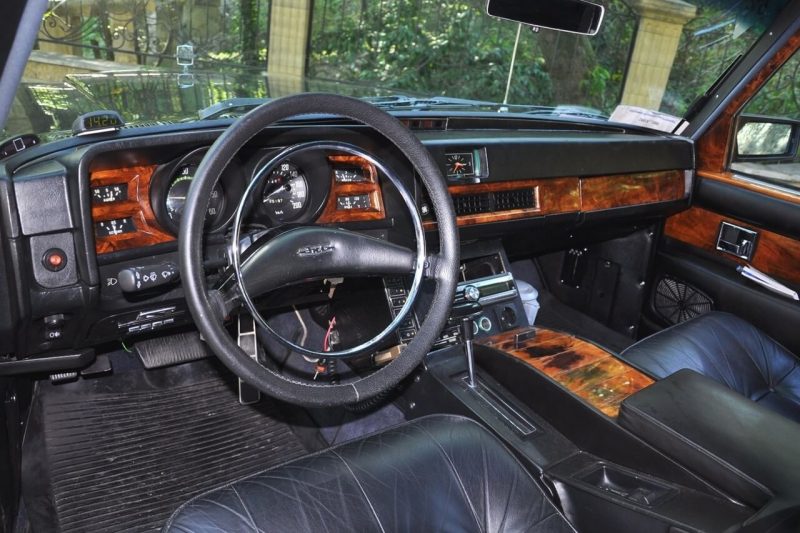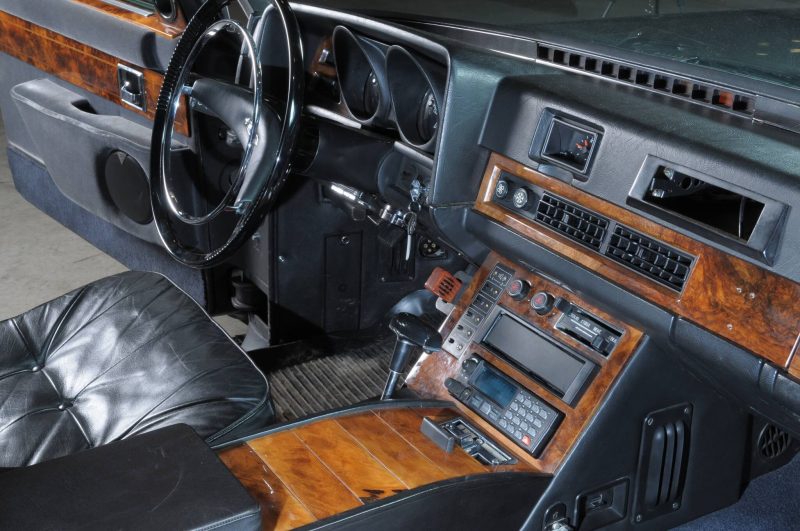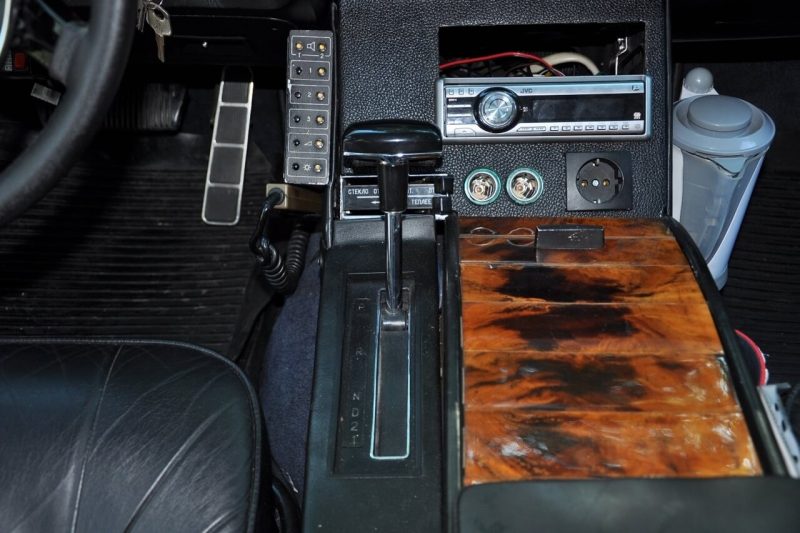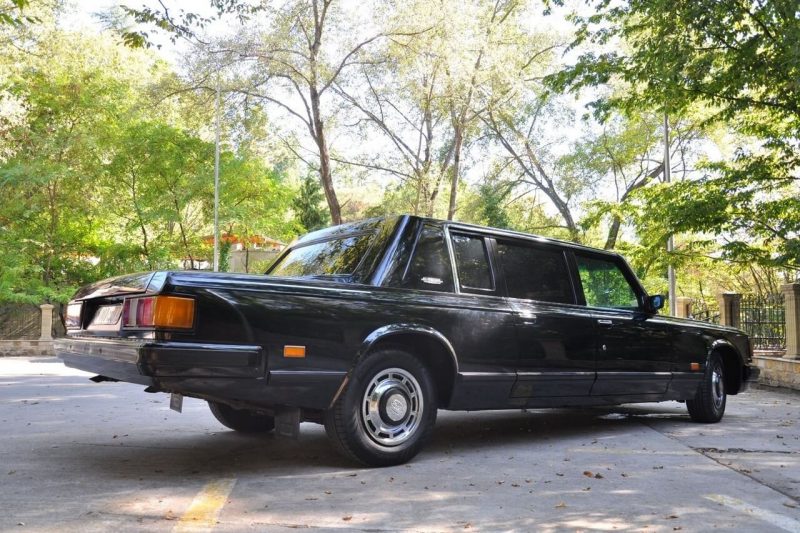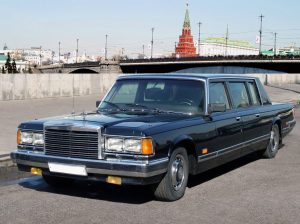ZIL-41047
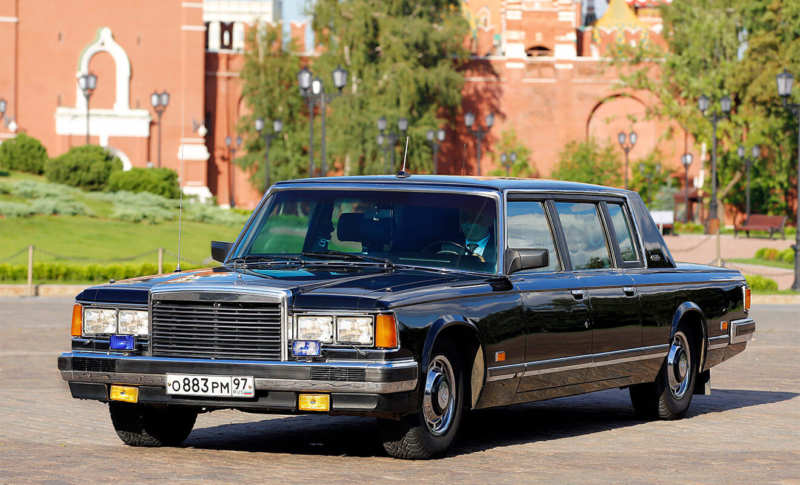
ZIL-41047 – representative class of the car in the body of the limousine type. This model is the final machine manufactured in the USSR, which was created without any material and technological limit. The position of the public government limousine gave the design staff the right to ignore the situation on the automotive market and the concept of “profitability”. Production started in 1985 and lasted until 2002. The whole model range is ZIL.
Car history
After Stalin’s death, armored cars were forgotten. New developments were not carried out and such vehicles were not used by party and country leaders. When Nikita Sergeyevich Khrushchev came to power, the armoured vehicles were stored in different garages and previous locations. Another part of these models was destroyed because of their non-use.
After the change of policy, the cars used by political people also changed. Today, it is believed that Nikita Sergeyevich held democratic views in comparison with Stalin, so his image was well suited to the same “democratic” vehicles. However, time has made it clear that armored versions should not be written off even in a fairly calm socialist hour.
As a confirmation of this, one terrorist attempted to kill Brezhnev in 1969, when he suddenly opened fire on two government vehicles during the celebrations with the cosmonauts. Although the head of state himself was not injured, as he was not driving at the beginning of the column, the driver of the first car was killed and some of the motorcade participants were injured. One of the safest cars in the world was a Russian version called ZIL-4105 (Bronecapsula).
The car had three modifications, which were distinguished by the front dodger – ZIL-4105, ZIL-41051 and ZIL-41052. Before the perestroika, the U.S. security services failed to reveal this secret. When the Union of Soviet Socialist Republics collapsed, they initially decided to acquire and explore the old ZIL.
In fact, the whole mystery of an armored sedan was pretty common. Taking into account the standard booking technologies, it is assumed that the regular structure of the armor components will be strengthened. It is no secret that Western countries are arming their cars, installing under the skin sheets of Kevlar, which has good strength when opening fire from small arms and quite well counteracts the blast wave. But the Kevlar cannot provide good protection against a more significant weapon.
Experts have estimated that the price of one such car is 600,000 U.S. dollars, but everywhere, officials never spare money for their safety.
The Russian design team chose a different way – they decided to weld an armored capsule, and then to build a car around it! Such a device is not completely suitable for mass production, in connection with this, only 25 such armored capsules were made at the Kurgan plant. Of these, 5 were designed for fire tests. This unique machine of the Likhachev plant has a maximum degree of safety.
The designers have made such a structure of the chassis that the car can not be overturned. It should be noted that its armor (steel 68HGSLMN with special additives) is the best in the world. The thickness of the armor ranges from 4-10 millimeters. The thickness of bulletproof glass: front glass is 43 millimeters, located on the sides and rear glass is 47 millimeters.
Fuel tanks made of a large number of layers, which could tighten openings on their own during breakdowns and were fire and explosion-proof, cost nothing. Their development and construction was carried out in the pilot production of the Research Institute of Steel. The curb weight of the sedan, taking into account the purpose of the armored vehicle and the installed equipment, was changed within the limits of 5 160-5 225 kilograms.
And now, when 1985 came, M. Gorbachev became the general secretary of the Central Committee of the Communist Party of the Soviet Union, and, accordingly, the head of the vast country, was relatively young (according to the criteria of the Soviet past). Judging by the announced policy of perestroika, ZIL’s experts were inspired by the modernization of the state limousine ZIL-41045, which was produced at that time.
The need for ongoing updating has been driven by more political motivations than technical ones. The chassis, together with the power unit, was designed with a powerful design “stock”, which allowed for several years not to change anything in the components and details. The point was that Mikhail Sergeyevich, if we compare it with the previous leaders, often visited foreign countries on official duty and traveled to the Union to a large extent.
It is clear that the car of a young, energetic and determined representative of the USSR should have had “more meaning” than the ceremonial protocol cars of its predecessors. In the Soviet Union, the newest vehicle of the head of the country, who announced the restructuring and reconstruction in all areas of life of the citizens, was supposed to represent certainty, desire to move ahead and irreversibility of reforms.
Abroad, the sedan was expected to be simple, so that the novelty “made an impression”. Therefore, already in 1986 the debut ZIL-41047 was released. The improvements affected the exterior design to a greater extent. It is better to look at the beginning of the grille cladding, and instead of round headlights began to install square (Bosch company).
The turntables decided to return to the corners of the wings in front, and the stern lights occupied the entire area of the rear. The front side windows no longer had vents, and the external mirrors got the newest body and were installed not on the door part, but in the corner of the window.
As of 1986, the ZIL-41047 was the world’s smallest and most ambitious passenger car.
Such small changes were enough to win everyone’s attention from the new model. The technical department also did not sit idly by, but made some improvements to the president’s sedan systems. The ZIL-4104 engine, which was a V-type, eight-cylinder engine with two camshafts in the heads of the unit, decided to upgrade and use a contactless ignition system.
With the advent of 1988, the hydromechanical gear, which was inherited from the previous version 41045, was also improved. The upgrade affected the freewheeling clutch and a number of adjacent elements, which increased the strength of the device. In addition, the novelty had a wheel diameter of 16 inches.
As tires used a version of the special purpose “Granite”, which had a system that facilitates movement in case of violation of the sealing of the wheel. This was possible with the help of stronger tyre sidewalls and a special gel in the middle. Such tire withstood up to 7 bullet penetrations.
Given the importance of the new president’s car, no one even had the idea of a possible manufacturing defect or design deficiency. Unsurpassed quality was one of the most important requirements and it was achieved by careful manual production, a large number of checks of certain components and each machine in general.
Such vehicles were assembled individually, according to the staging method: the car did not follow the conveyor from master to master, and the employees of one or another department came to the car on demand. The assembly time lasted about five and a half months. In one year they produced no more than 15-20 presidential sedans. Body panels were made of oak templates by hand.
After that, they were installed on the vehicle, adjusted on site, straightened and leveled with tin alloy. Manual work and individual adjustment of elements were widely used. Since the models were aimed at a certain “buyer”, the sedans were distinguished by filling, arrangement of certain knots and the basis of finishing.
For dyeing they used nitro enamel with a coating of 9-15 layers. Intermediate drying and polishing of each layer was used. The extreme layer was applied and polished only when the model passed the running-in tests. Interestingly, any machine after such a test could have run up to 2,000 kilometers.
Exterior
As it is already clear from the photos, the appearance of the presidential car is quite unusual. If you look at the photo, you will immediately notice a 1.5-meter long stern overhang, a large hood and luggage compartment. After that, it is possible to notice the presence of deep body colouring.
The wheelbase has received 3,880 millimeters, and it is so big that even the Mercedes S-class W140 and the new Mercedes W222 look small compared to the domestic model. As mentioned above, the front square headlights were produced by Bosch, and also had small “wipers”.
It is noteworthy that the placed external mirrors in the corner of the glass were equipped with an electric drive. Unusually, but the previous Mercedes (W140) with a body pointer W126 had no mirror on the right side. If you take the car of the President with the index 41047, the novelty did not get swivel vents in the front doors.
At detailed inspection of the new Soviet vehicle, you can see rubber plugs in the wings, located in front. Such holes are intended for special pins, which are called flagpins. They are intended for the installation of a flag and a similar part is available only for cars of the Likhachev plant. GAZ 14 Chaika does not provide such equipment.
The desire to add integrity to the body is also noticeable in the gas tank covered behind the rear number. The tank itself received a volume of 120 liters. The nameplate mounted on the bonnet is injury-proof and hides when pressed. The height of the ground clearance does not fall below 170 millimeters.
Interior
Construction and finishing of interior decoration has always been considered an important point during the development of vehicles of the representative niche. When comparing the models with previous releases, the novelty in terms of equipment and aesthetics of the interior of the limousine has almost not changed.
The developers provided for 7 seats with 3 rows of seats inside the presidential car: the middle row was installed with strapons, which killed themselves in the partition between the VIP-salon and the seats installed in front. Adjustable column of a steering wheel can be deflected upwards that essentially simplifies landing of the driver of a vehicle.
The rear-mounted sofa could be electrically powered, allowing the backrest to be adjusted to the angle of inclination and position of each seat. The front seats were upholstered with leather only, and the rear row was furnished with plush or velour upholstery. The twin-spoke steering wheel of the classic type has been adjusted to the angle of inclination.
The driver’s seat has different settings. It can be adjusted almost as desired. When finishing the interior ZIL-41047 used inserts made of natural walnut wood, and in some cases – mahogany. The climate situation inside the presidential limousine is the responsibility of the climate installation, one on the passenger side and the other on the driver’s side.
The presence of deterministic three-layer glasses helps to maintain the required temperature. Interestingly, the first models of the Soviet representative sedan had Belgian glass, all the following – domestic. Interior lighting is individual, as there are separate lamps on the ceiling and corners.
The lower edge of the door armrests is equipped with special lamps, which are lit during the opening of the doors. Russian specialists decided to make a non-standard “handbrake”. To activate it, it is necessary to use a foot pedal (the same principle is applied on Mercedes).
Executive limousine ZIL-41047 has an excellent level of noise insulation, as a layer of material that provides it, is imposed a thickness of 5 cm.
Electric drives of partitions and window lifters have been installed on the upper surface of the door armrests installed at the back. The rear doors can be opened to both passengers and driver from the straponents. The armrest located on the right side was fitted with buttons for setting up the “music” system and window lifters.
The console, located in the center of the presidential limousine, has air conditioning units, loudspeaker, alarm system and basic music system. A compartment for the special communication unit is placed between the front seats. The speed sensor, together with the tachometer, was placed in round wells, covered with cone-shaped glasses, which fully prevents glare.
Specifications
Powertrain
Nowadays, a large number of motorists are delighted with foreign vehicles with V8 power units of 5.6 liters volume on board, but if we compare them with ZILOVsky engine, foreign variants look “toy”. The massive hood cover of the Soviet huge limousine hides a V-shaped, eight-cylinder, 16-valve, 7.7-liter engine.
Such “engine” develops 315 horsepower, but that’s not all! It produces 608 N/m of torque at 2,500 revolutions per minute – this figure exceeds the data of Nissan GT-R and is similar to the new Jeep Grand Cherokee SRT. The latest model stands out among the first places among most sports cars, leaving them behind.
This power pack is powered by a four-chamber carburetor and extracts the spark from the spark plugs with a contactless ignition. The type of gas distribution mechanism drive is OHC. The unit is made of aluminium and the engine has two camshafts.
Each cylinder has a combustion chamber volume of almost a liter. Such engines are installed on Toyota Yaris or Daewoo Matiz. Such “engine” allows to accelerate a heavy limousine up to a speed mark of 100 km/h. in 13 seconds, and the maximum speed is 190 kilometers per hour.
Transmission
The torque from such a powerful engine was transmitted to the wheels of a three-speed hydraulic transmission on the “machine” and a 3-speed gearbox of the planetary unit. Only the rear wheels were provided as the drive. The PTO shaft received an intermediate support.
Continuous rear axle was equipped with hypoid main gear. A gearshift selector was installed on a transmission tunnel between the front seats. The gearbox is equipped with a mechanical stopper to hold the machine on the climb. It switches off automatically as soon as the car leaves the area.
Running gear
Ahead of the Soviet model we decided to install an independent, hingeless suspension on the transverse levers, where there is also a stabilizer of transverse stability. A 28 mm torsion was used as an elastic part, mounted along the frame, which has an effect on the lower arm.
At the back they used a dependent suspension, where there are asymmetrical semi-elliptic longitudinal springs and reactive draught. Long leaf springs (1,550 mm) had a gasket between the sheets of polyethylene type. Both suspensions received telescopic shock absorbers.
Steering and braking system
The experts decided to use a ball screw nut with toothed sector as a steering device. All this is complemented by hydraulic power steering. The brake system has disc 292.2 mm vented front and rear 315.7 mm brakes.
Hydraulic drive is a two-circuit type, each of which affects the brakes of 4 wheels. The parking brake is equipped with a drum kit. The drive is carried out by means of the left pedal.
Security
Armored models of ZILA 41047 were produced only in quantity of 14 pieces. These vehicles ensured the safety of all passengers. Some government vehicle seats are 8 centimeters thick! The glass thickness is 8.5 centimeters! Even 7.62 caliber bullets with a hardened armor-piercing core cannot pass through them.
The car withstood a grenade explosion on the roof and even under the fuel tank. As mentioned above, the presidential limousine was not even afraid of punctures in the wheels, which allowed it to leave the “dangerous place” as soon as possible. It is also noteworthy that the Soviet car is almost impossible to flip over – this once again eloquently testifies to the high level of security.
Price and equipment
Today the price of the Soviet limousine ZIL-41047 starts at 10 000 000 Russian rubles. But it is necessary to notice at once that in the secondary market of similar offers very little. Basic equipment has a 7.7-liter 315 hp power unit, hydraulic power steering, separate “climatic” system, air conditioning, velour saloon, power windows of front and rear windows, seat adjustment.
Modifications
| ZIL-41047 | It is a basic model with seven seats in the body of a limousine, wheelbase 3 880 millimeters (1985-2000) |
| ZIL-41041 | It was released from 1986 to 2000. The model is made on a limousine platform (41047) and is an escort vehicle in a 5-seater sedan body with a cut base up to 3 300 millimeters. Due to the fact that the car has become not so long (5,750 millimeters) and not so heavy (up to 3,160 kilograms), its dynamic data has increased. Officially the construction of such vehicles has not been completed, but in reality they are not produced. A total of 26 models have been produced. |
| ZIL-41042 | Along with the design of the limousine, the specialists prepared for the production of its sanitary performance – a car in the body of a universal with the index 41042. In order to separate such vehicles from the state columns, they were painted black. Because of this, they were often called the “Black Doctor”. Despite popular opinions, the equipment of this modification was not suitable for the conditions of reanimated cars. ZIL-41042 was suitable for transportation of influential patients with necessary hospitalization. The vehicle is provided for a crew of 3 doctors and one patient, for whom a lying place is provided. The body length was increased, and a superstructure was installed on top of the medical part of the interior decoration. The stern door had two compartments: the one at the top was raised and the one at the bottom was tilted. The weight of the universal was 3.9 tons. The stern door, located on the left, was artificial, behind it there was a “spare” and a tool. Inside, the Soviet station wagon was able to finish very well, even the stretcher was made using genuine leather. The medical station wagons produced on the “trolley” 41045 and 41047 had the same index – ZIL 41042. Built limousines on the “trolley” 41047 stood out due to the presence of a monolithic stern door, which rose up. A total of 4 ambulances were produced. |
| ZIL-41043 | Represents a special communication machine, which was produced since 1980-1983 on the platform of the universal (41042). This version had a shielded system of electrical equipment and a parabolic antenna of government communications mounted in the roof. |
| ZIL-41044 Phaeton | With the advent of 1981, the Likhachev company built a front phaeton with the index 41044, which had an automatic folding top (the duration of lowering and raising did not exceed 20 seconds), and “hiding” in an automatic order frame of side windows. Differences from the standard version were as follows: the car received a pair of doors, the right seat was absent, and the center of the interior was set up with a cabinet with a handrail. In addition to all the ZIL-41044 Phaeton was equipped with several microphones, as well as a radio station and antennas. In total, 3 such “machines” were produced. |
| ZIL-41045 | This modification was made from 1983 to 1985. After the arrival of the next Secretary General of the Central Committee of the Communist Party of the Soviet Union (1983), the limousine moved cosmetic restyling of the exterior. The decision was made to remove the shiny onlays from the arches of the wheels, and the molding that went up the threshold was placed higher on the door. The radiator grille, along with the headlamps, was modified, and the stern lanterns received a slightly different design. |
| ZIL-41046 | Served as a connecting vehicle, produced on the “trolley” ZIL-4104. From the outside, such a design did not stand out from the standard one. On version 41046 there was shielded electric wiring and special communication technology “Kavkaz”. |
| ZIL-41048 | The car was produced in 1984 in the quantity of one copy, which differed by a peculiar climate control. |
| ZIL-41049 | Represents the machine of special communication on a platform 41047. In total, only 2 copies were produced. |
| ZIL-4105 Armourcapsule | This armored version of the car had 3 versions. As described above, the structure was the so-called armored capsule. The body itself was built around it. |
| ZIL-41072 Scorpion | It is a special-purpose security vehicle built in 1989. This version was equipped with wide steps, external and internal handrails on the sides of the car and inside it. The roof hatch is suitable for “contingencies”. The Soviet modification had a design of a momentary opening of the aft window. The developers provided a special interior layout with swivel chairs. A total of 8 such machines were produced. |
The pros and cons
Pluses cars
- Quite a nice look;
- High level of security;
- Excellent stability on the road;
- Powerful power unit;
- Solid dynamic characteristics, as for such mass of the car;
- Qualitative assemblage;
- Inside a lot of free space;
- The big luggage branch;
- Qualitative salon;
- Expensive finishing;
- High level of comfort;
- “Climatic installation”;
- Hydraulic power steering;
- Various adjustments of a steering column and seats;
- Good noise insulation.
Cons of a car
- Big size;
- High consumption of gasoline;
- High cost due to small-scale production;
- The quality of the used plastic of the front panel leaves much to be desired;
- Uncomfortable transmission tunnel.
We sum up
It is a pity, but the company could not find buyers, so even small-scale production was stopped. Many officials today prefer eminent foreign brands to Soviet manufacturers. But despite all this, ZIL-41047 was one of the safest cars in many countries in its years. The car has a good and pleasant appearance, stylish front end and large dimensions.
The acceptable height of road clearance allows the vehicle not to worry about the quality of the road surface. Once inside the car, you may at first feel as if you are in a foreign car and only the logo of the steering wheel reminds you that this presidential limousine was built by the Likhachev plant.
By the way, the steering wheel has a hydraulic booster, which makes it much easier to drive a bulky car, and the steering column can be adjusted to the preferences of any driver. The presence of real wood and pleasant interior cladding is a pleasure. Also it is necessary to notice comfortable and pleasant seats, which have received various adjustments.
There is plenty of free space inside, especially on the second row. Doors are wide enough, so to get in and out of the car is not difficult. Luggage compartment also has a lot of useful volume. The technical side of the limousine has a powerful power plant, which allows such a large and heavy car to be dynamic.
It is worth mentioning separately the high degree of security, which was specifically aimed at the top officials of the state. For a long time, such a car simply did not have any such characteristics, as even special events were held, where foreign specialists tried to turn the limousine upside down, but they failed to do so. Thick metal and window armour allowed to get out of the most difficult situations and save the lives of important passengers.
It is also important that on this platform was built a lot of various modifications of special vehicles, which are also often in the motorcades or on special assignments. Today, such cars can be found in a museum or in the garages of private collectors. Such a car will be remembered for a long time as a fast, convenient, safe and prestigious limousine for government officials.
We advise you to read the article: ZIL – history of the giant





